Introduction
Tomato Mosaic Virus (ToMV) is a viral disease that affects tomatoes and other members of the Solanaceae family. It is a significant threat to tomato crops worldwide, causing a wide range of symptoms, from mild discoloration to severe yield loss. Understanding the causes, symptoms, transmission, and management of this disease is essential for gardeners and commercial growers to safeguard their crops.
What is Tomato Mosaic Virus?
Tomato Mosaic Virus is a member of the Tobamovirus group, which is known for its ability to infect a wide variety of plants. The virus primarily affects tomatoes but can also infect other crops such as peppers, eggplants, and tobacco. Tomato Mosaic Virus is known for its persistence and ability to remain viable in plant debris for extended periods, making it difficult to eradicate once it takes hold.
Symptoms of Tomato Mosaic Virus
The symptoms of Tomato Mosaic Virus can vary depending on the tomato variety, the environmental conditions, and the age of the plant. However, the most common symptoms include:
- Mosaic Pattern on Leaves: One of the hallmark signs of ToMV is a mosaic pattern of light and dark green areas on the leaves. This can result in a mottled or variegated appearance.
- Leaf Curling and Deformation: Infected leaves often curl and become distorted. This can interfere with the plant’s ability to photosynthesize properly.
- Stunted Growth: Tomato plants infected with ToMV often exhibit stunted growth, with leaves and stems remaining small and underdeveloped.
- Yellowing of Leaves: The lower leaves may turn yellow and die prematurely.
- Reduced Fruit Yield and Quality: Infected plants may produce fewer fruits, and the fruits may show deformities, such as discoloration or abnormal growth patterns.
- Chlorotic Spots: Some plants may also develop yellow spots or lesions on the leaves.
These symptoms can range from mild to severe, and while some plants may survive the infection, the overall yield and quality of the crop are typically reduced.
How is Tomato Mosaic Virus Transmitted?
Tomato Mosaic Virus is primarily transmitted through mechanical means, such as:
- Infected Seeds: The virus can be present in tomato seeds, which means that planting infected seeds can spread the disease to new plants.
- Contaminated Tools and Equipment: The virus can be spread through the use of contaminated gardening tools, such as pruning shears, knives, or even hands, when handling infected plants.
- Infected Plant Debris: The virus can remain viable in infected plant debris for months or even years, so using contaminated soil or plant material can introduce the virus to new crops.
- Infected Transplants: Purchasing infected seedlings or transplants from unreliable sources can also contribute to the spread of the virus.
Once the virus enters the plant through physical damage or infected plant material, it moves through the plant’s vascular system, causing systemic infection and widespread symptoms.
Managing Tomato Mosaic Virus
While there is no cure for Tomato Mosaic Virus, several management practices can help minimize the impact of the virus and prevent its spread.
1. Use Disease-Free Seeds and Transplants
Always start with disease-free seeds or certified disease-free transplants. Many seed suppliers offer virus-free tomato seeds, which is a reliable way to prevent infection. Additionally, avoid using seeds saved from infected plants.
2. Sanitize Tools and Equipment
Regularly clean and disinfect gardening tools, such as pruning shears, knives, and stakes. This helps reduce the mechanical transmission of the virus. Using a bleach solution (10% bleach to 90% water) is an effective way to disinfect tools between uses.
3. Practice Crop Rotation
Rotate crops to reduce the buildup of the virus in the soil. Planting tomatoes and other susceptible crops in the same location year after year increases the likelihood of virus transmission. By rotating crops with non-host plants, you can decrease the risk of reinfection.
4. Remove Infected Plants Promptly
If you notice symptoms of Tomato Mosaic Virus in your plants, immediately remove and destroy the infected plants. Do not compost infected material, as the virus can survive in the compost pile. Instead, dispose of the infected plant material by burying it or burning it.
5. Maintain Plant Health
Healthy plants are better able to resist infections, so ensure that your tomato plants are growing in optimal conditions. Proper watering, good soil fertility, and appropriate spacing can help maintain plant health, making them less susceptible to viral diseases.
6. Control Weeds
Weeds can serve as reservoirs for plant viruses, so it is important to regularly remove weeds from the garden. Weeds may harbor the virus and act as a source of infection for your tomato plants.
7. Use Resistant Varieties
While there are no treatments to cure Tomato Mosaic Virus once a plant is infected, certain tomato varieties are resistant to the virus. Consider planting resistant varieties, such as those labeled with “Tm” resistance, which are specifically bred to withstand infection by Tomato Mosaic Virus.
Conclusion
Tomato Mosaic Virus is a challenging and persistent disease that can significantly affect tomato crops. By understanding its symptoms, transmission methods, and implementing proper management practices, you can protect your tomato plants from this viral threat. Prevention is key, and by using disease-free seeds, maintaining garden hygiene, rotating crops, and selecting resistant varieties, growers can reduce the impact of this virus on their crops and ensure healthy, productive tomato plants.

1 thought on “Understanding Tomato Mosaic Virus: Symptoms, Causes, and Management”